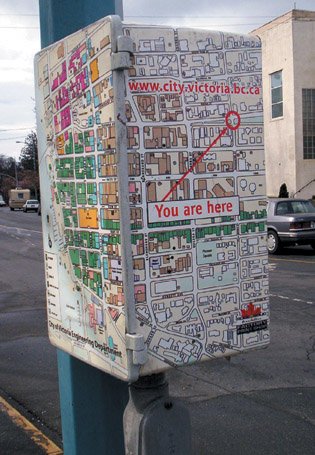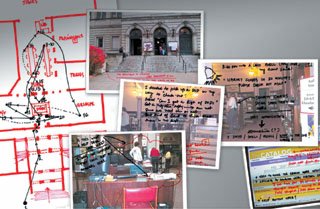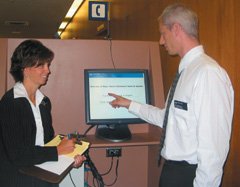The Differences Between Services and Products
| Thanks to technology, our products and services are intertwined as never before. We subscribe to phone services to use our mobile phones. We pay to connect our devices to the Internet. We order goods online that are delivered to our homes, and withdraw money from our banks via machines. Most services are chock-full of productsa fact sometimes overlooked in discussions of service design. Signage, physical devices, Web sites, phone services, lighting, and so on are all part of a typical modern service ecology. The corner store has signs, counters, display shelves, and probably even a Web site. Many of these are specialized products made specifically for that service (Figure 8.9). The TiVo box, for example, is a specialized product that you have to buy before you can even use the TiVo service, which provides not only the TV listings, but also the TiVo operating system. (Imagine subscribing to Microsoft Windows.) Figure 8.9. A very clever map, using the otherwise wasted space of a utility box, designed for that particular box as part of a tourism service for the city of Victoria, British Columbia.
courtesy of Rachel M. Murray Services, however, have different emotional resonances with users than do individual products. While users may strongly like a service such as TiVo, the attachment that forms to a service is different than that to a physical product. For one thing, services are intangible and likely to change. Services mutate, stagnate, and shift depending on the people supplying them and the business rules that guide them. The experiences at McDonald's and Starbucks can vary wildly, and those businesses both have very controlled service processes.
I own a Zippo lighter that belonged to my grandfather. Barring catastrophe, that Zippo will always be the same. It's tangible: I can touch it, use it, see it easily. Not so with services, especially digital services, many of which change frequently. And, truth be told, customers can easily switch services as well. If an auction service better than eBay came along, users would switch. Even if my grandfather had used eBay, that probably wouldn't stop me from changing to a new service if something better came along. But I won't trade in my grandfather's Zippo for something better. I have an attachment to it. It's sentimental, sure, but humans are emotional creatures and don't always make logical decisions. The point is that people, probably because of their biological wiring, more easily form emotional attachments to things than to intangible services. Note There are certainly productsmany productsthat we don't notice, enjoy, or have an attachment to: namely, those that are poorly designed, difficult to use, ugly, or simply dated. Services that replace these products, such as TiVo, which provides much more convenience than traditional television sets, are certainly appreciated and welcomed. On the Internet, it's practically impossible to separate product design from service design. Most noncontent Web sites provide services delivered over the Internet instead of in person. Google, eBay, Yahoo, online brokerages and banks, travel sites, and so on all provide services or are part of larger services that combine both online and offline products, as in the case of Netflix, which has both a Web site for ordering DVDs and mailers (Figure 8.10) for sending and returning them. Users don't own the Web site (obviously)they just use the servicewhich makes most Web services vulnerable. If a search engine that was better than Google came along would you use it? You might. This is one of the reasons why companies like Google and Yahoo give users digital objects like toolbars. It's easier to switch services than it is to get rid of a thing, even a digital thing. Figure 8.10. The current Netflix mailer, introduced in early 2005. The result of more than five years of experimentation, this mailer transports approximately 1.4 million DVDs a day to Netflix's 4.2 million subscribers.
The Craft of Service DesignBecause service design itself is new, the service design process is still being developed. But interaction designers who work in service design have methods they use to craft services, in addition to most of the techniques described in Chapter 5. These methods have been developed by service design consultancies such as IDEO and Live|Work and by designers such as Shelley Evenson (see the interview in this chapter). Note The business community, too, has spent considerable time and effort thinking about services. Interaction designers working in service design should draw upon this community's experience while bringing to the table the approaches and methods of design (see Chapter 2 and Chapter 5). Environment DescriptionBefore starting the design of a service, designers need to know as much as they can about where the service will be located (or is located already). An environment description details the location as much as possible. Maps, diagrams, blueprints, photographs, screenshots, and videos can all be part of an environment description. Photographs with annotations (Figure 8.11) are excellent for environment descriptions. Figure 8.11. Annotated photographs from a project done with the Carnegie Library of Pittsburgh by MAYA.
courtesy of MAYA Stakeholder DescriptionAs discussed earlier, the users of services are both customers and employees. But services, because they often live in a physical context, affect more than just their direct users. A change to a bus route may, for instance, affect thousands who never take the bus: the newsstand that depends on the riders for business, drivers in cars, the people living on the bus route, city officials, taxi drivers who compete with the service, and so on. The designer needs to identify both the obvious and the nonobvious stakeholders who are affected by the service. Designers may have to make some difficult choices in regards to these stakeholders. The new service may be better than what currently exists, but at what cost? How many mom-and-pop stores has Wal-Mart driven out of business? How many local coffee shops has Starbucks ruined? Designers often need to prioritize the stakeholders. A hard fact of designing is that the neighbor down the street is often less important than the customer. Services can have a human cost that designers need to consider. Company Perceptions and BrandingUnless a service is new and for a new company, customers will likely have expectations about how the service will work based on the company's brand and their own experiences with the company. Designers need to be aware of these expectations and to design the service appropriately. Designers also need to ask frankly whether this service is appropriate for the company, or how it can be made appropriate. Some companies and brands such as Virgin Group, Ltd., seem infinitely flexible, with services running the gamut from online music downloading to space travelbut most aren't. If BMW suddenly wanted to offer health care services, you'd have to wonder if the CEO went off his medication. Designers also need to figure out what the company is good at so that any new service draws on those strengths. If a company is known for its great customer service, as Southwest Airlines is, the designer would be foolish not to capitalize on that. TouchpointsDesigners need to compile a list of all the touchpoints to understand what raw materials they have to work with or need to create. These touchpoints can include (and certainly aren't limited to) any of the following:
Do these exist already or do they need to be created? Are they well designed or are they trouble spots? These touchpoints are the raw materials that interaction designers work with. Once the list of existing and potential touchpoints has been created, it can be used to brainstorm designs for each touchpoint. Touchpoints are used in both the process map and the service blueprint. Process MapNo service exists in a vacuum. Indeed, many services exist only when connected to other services. For example, the service of ordering a monthly parking pass at a garage makes no sense without the parking service itself. But before starting work on the parking service, the interaction designer needs to see how that part fits into the overall customer pathway, which includes possibly the purchase of a monthly pass. A process map (Figure 8.12) provides this overview. Figure 8.12. Process maps provide an overview of what is to be designed and can indicate problem areas in an existing service.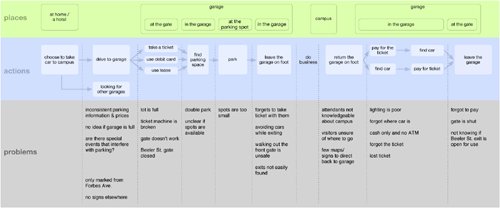 courtesy of Yuan-Chou Chung A process map shows the high-level view of the overall experience and where the design work being done falls in that overall experience. How might a project that designs the service on a plane affect the check-in service? A process map shows the boundaries of the project. While a process map does show steps in the process similar to a task flow (see Chapter 5), one major difference is that a process map can also show the surrounding steps that are not going to be designed. Process maps should also indicate the touchpoints at each stage of the process. When checking in at an airport, for example, the touchpoints include the human agent, the kiosk, the ticket, the ticket sleeve, and the counter. A process map can also point out areas of trouble and missed opportunities. Perhaps a crucial step in the process is missing or poorly designed. Perhaps there aren't enough touchpoints to complete the users' tasks. These issues get addressed in the service blueprint. Service BlueprintMuch as wireframes are key documents for digital products (see Chapter 5), service blueprints (Figure 8.13) are critical documents for services. Service blueprints present two major elements: service moments and the service string. Figure 8.13. A piece of a service blueprint, part of the MAYA Carnegie Library of Pittsburgh project. Service blueprints show not only discrete moments in the service, but also how those moments flow together in a service string.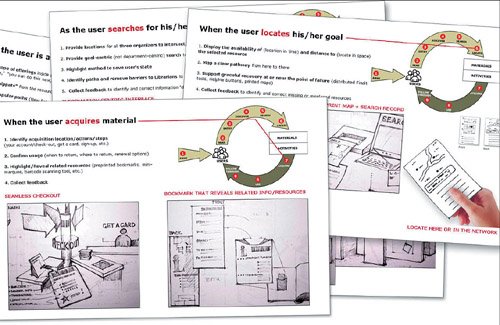 courtesy of MAYA Service MomentsEvery service is composed of a set of discrete moments that can be designed. For example, a car wash service has (at least) the following service moments:
Each of these moments can be designed, right down to how the nozzles spray water onto the car. The service blueprint should include all of these moments and present designs for each one. And since there can be multiple paths through a service, there can be multiple designs for each moment. In the car wash scenario, perhaps there are multiple ways of finding the car wash: signs, advertisements, a barker on the street, fliers, and so on. Here, the list of touchpoints can come into play. Which touchpoint is or could be used during each service moment? For each service moment, the touchpoints should be designed. In our car wash example, for instance, the customer paying moment probably has at least two touchpoints: a sign listing the washing services available and their costs, and some sort of machine or human attendant who takes the customer's money. All of these elementswhat the sign says and how it says it, how the machine operates (Does it accept credit cards? How does it make change?), what the attendant says and doescan be designed. A major part of the service blueprint should be the brainstormed ideas for each touchpoint at each service moment. Each service moment should have a concept attached to it, such as the sketches in Figure 8.13 showing a possible check-out kiosk and a bookmark for related library information. Ideally, each moment should have a sketch or photograph or other rendering of the design, similar to single storyboard frames. For each service moment, the service blueprint should show what service elements are affected: the environment, objects, processes, and people involved. Designers should especially look for service moments that can deliver high value for a low cost. Sometimes small, low-cost changes or additions to a service can quickly provide high value to users. For instance, some airlines found that passengers want a drink as soon as they board the plane. But because other passengers are still boarding and in the aisle, flight attendants can't offer drink service at that time. The solution was to put a cooler with water bottles at the front of the plane, so that passengers, if they want, can get a drink as they boarda low-cost, high-value solution. Service StringThe second component of a service blueprint is the service string. The service string shows the big idea for the service in written and visual form, usually in the form of storyboards (see Chapter 5). Designers create service strings by putting concepts for various service moments together to form a scenario, or string, of events that provide a pathway through the service. The service string demonstrates in a vivid way what the pathways through the service will be and provides a comprehensive, big-picture view of the new service. Viewers can see how customers order, pay for, and receive the service, and how employees provide the service. For example, a service string for the earlier car wash example would show in a single scenario customers seeing the new signs, customers using the new machine to pay for the car wash, the special washing service, the attendants who hand-dry the cars, and the new vacuum for cleaning out the cars after they are washed. Service PrototypePrototyping a service usually isn't much like prototyping a product. Since both the process and people are so important to services, services don't really come alive until people are using the service and walking through the process. Prototyping a service typically involves creating scenarios based on the service moments outlined in the service blueprint and acting them out with clients and stakeholders, playing out the scenarios as theatre. Role playing constitutes a significant part of the service design process. Only through enactments can designers really determine how the service will feel. Someone (often the designer) is cast in the role of employee, while others play the roles of customers. This prototyping can make use of a script or an outline of a script, or the enactments can simply be improvised. The players act their way through a service string to demonstrate how the service works. Ideally, these scenarios will be played within a mock-up of the environment (Figure 8.14), with prototypes of the objects involved as well. Only in this way can the flow and feel of the service really be known. Environments can be simulated using giant foam blocks for objects, masking tape on the floor to block out areas, images projected on walls, and so on. Figure 8.14. A prototype of a service design environment, created by projecting images behind the designers/actors.
courtesy of Annie Ha, Rosemary Lapka, Jeewon Lee, Purin Phanichphant, and Dan Saffer Services, as with beta software, also can be prototyped using a live environment with real customers and employees. The Mayo Clinic's SPARC program does this (see the case study that follows), as do many retail stores, using what are called pilot programs at a small number of locations. These prototypes are, of course, extremely high fidelity, working exactly as the actual service would because they involve actual customers. Although it is certainly best to start with low-fidelity service prototypes (if only because of the cost), eventually the service will need to be tested with actual customers and employees, either in a prototype/pilot environment or live, making adjustments as the service lives.
|
EAN: 2147483647
Pages: 110
